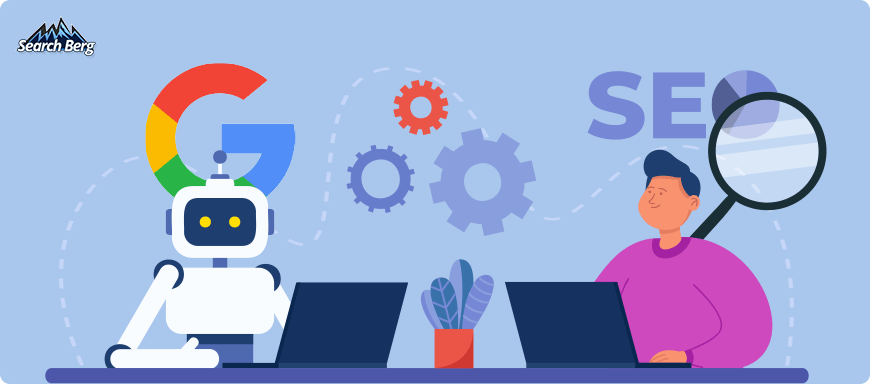Google’s New SEO Advice for AI Overviews: What Small Businesses Need to Know
Google’s latest SEO guidance for AI Overviews emphasizes quality content and technical readiness

A concept illustration of an SEO expert and Google’s AI Overview “bot” interacting.
Highlights
- Google AI Overviews prioritize content that is original, satisfying, and people-first
- Your content must be technically sound, mobile-friendly, and easy to navigate
- Structured data, images, and video play a bigger role in AI-driven results
- A new era of long-form, follow-up-heavy queries requires deeper, more helpful content
As AI Overviews and AI Mode continue rolling out, the face of search is shifting yet again. Small business owners who’ve just wrapped their heads around Core Web Vitals or mobile-first indexing are now wondering: what the heck is AI Mode, and how do I show up in it?
Here’s the answer from Google itself: the principles haven’t changed, but the stakes have. If your content isn’t useful, satisfying, and technically accessible, it’s not just going to rank lower. It may not show up at all.
Google’s own Search Advocate, John Mueller, published official advice this week outlining exactly how to succeed in its AI-powered search features. And for small business websites trying to stay visible and competitive, this guidance isn’t optional; it’s survival fuel.
What Google Has Officially Said About Succeeding in AI Overviews & AI Mode
1. Prioritize Original, People-Centered Content
Google’s core advice remains unchanged: your primary focus should be your audience. AI Overviews and AI Mode are designed to elevate content that is genuinely useful and distinctive. If your pages offer original insights and satisfy specific user queries, they’re more likely to be selected and cited by AI summaries.
2. Avoid Generic “Commodity” Content
If your content sounds like it could have come from anywhere, it likely won’t be favored by AI search experiences. Google wants you to create material that reflects real expertise, offers unique perspectives, and goes deeper than surface-level summaries.
3. Deliver a High-Quality Page Experience
Even top-tier content can lose its impact if users land on a cluttered, slow, or confusing page. Google highlights that your site should load quickly, adapt well to all devices (especially mobile), and make the main content easy to find. This holds true across both AI and traditional search results.
4. Ensure Technical Visibility
To be considered for AI Overviews or AI Mode, your website needs to meet standard technical SEO requirements.
This includes:
- Ensuring Googlebot isn’t blocked
- Returning a valid HTTP status (like 200 OK)
- Making sure the content is actually indexable
These steps help Google find, crawl, and evaluate your pages effectively.
5. Use Meta Controls to Manage Visibility in AI
Site owners still have control over whether their content shows up in AI formats. You can use existing tags like nosnippet, data-nosnippet, max-snippet, or noindex to control what parts of your content are visible or to opt out entirely. However, limiting snippet access will reduce your visibility in AI-generated summaries.
6. Keep Structured Data Accurate and Transparent
Structured data helps Google’s systems better understand your content and can qualify it for rich results or feature placement. But Google warns: any structured data used must accurately reflect what’s visibly on the page. Misaligned or misleading markup can backfire.
7. Support Content with High-Quality Images and Video
With multimodal searches becoming more common (e.g., uploading an image and asking a question), Google encourages site owners to incorporate visual media. Supporting your text with relevant, high-quality visuals can improve how your site performs in these search formats.
8. Don’t Just Chase Clicks, Track Value
Google notes that traffic from AI Overviews tends to be more meaningful. These visitors often spend more time on-site and engage more deeply with content. Instead of focusing purely on click volume, Google advises businesses to look at broader success metrics: conversions, signups, time on site, or information engagement.
9. Stay Flexible as Search Evolves
The “ten blue links” are no longer the whole picture. Just as Google adapted to mobile-first indexing and voice search, AI search is the next big shift. These changes bring new challenges, but also new opportunities. Google says businesses that evolve with users and keep quality at the center of their strategy are well-positioned for long-term success.
What Search Berg Recommends
Google’s advice is solid, but how do you translate it into steps you can actually take?
At Search Berg, we work with thousands of small businesses, and we know what it takes to survive algorithm shifts without panic.
In light of Google’s guidelines, here’s what we recommend:
1. Make Your Content Worth Quoting
Google’s AI Overviews are looking for content that adds something new. If your site regurgitates what’s already out there, you’re invisible.
Focus on:
- Answering the kinds of specific, detailed questions your real customers ask
- Adding personal insights, examples, or localized tips no one else is offering
- Avoiding copycat content or low-effort blog posts created just to “rank”
Pro Tip: Use your service pages and blog posts to educate, not just sell.
2. Fix the Basics Before Chasing Visibility
Before you worry about AI Overviews, ask: Can Google even access your site properly?
Many small businesses lose traffic not because of poor content, but because:
- Their pages aren’t indexed
- Mobile versions are broken
- Sites load like it’s still 2012
Run a full site audit. If you’re not sure how, we can help. But without this foundation, AI won’t even look in your direction.
3. Don’t Just Post, Package Your Content
Google’s AI doesn’t just read, it analyzes. If your content is wrapped in outdated design, missing images, or drowned in pop-ups, it’ll underperform.
Do this instead:
- Use headers and clear formatting to guide both users and crawlers
- Add images that clarify your content (not random stock photos)
- Consider short explainer videos or customer testimonials embedded on key pages
AI rewards content that looks and feels “complete.”
4. Update Your Merchant Center and Google Business Profile
Especially if you’re in eCommerce or service-based industries, keeping your Merchant Center or GBP updated is imperative. AI Overviews will pull business details, ratings, and visual previews from these sources.
Check:
- Your product or service categories
- Business hours, phone numbers, and service areas
- Recent reviews and whether you’re responding to them
The richer your listings, the more AI has to work with.
5. Measure Engagement, Not Just Clicks
AI-driven search might bring fewer total clicks, but they’ll be better clicks. These users are more curious, more informed, and closer to taking action.
Focus on:
- Time on page
- Scroll depth
- Conversions (calls, form fills, sign-ups, purchases)
Small tweaks in how you track performance can reveal huge growth opportunities under the AI model.
6. Use Snippet Controls Strategically, Not Fearfully
Don’t rush to block AI access out of fear it’s “stealing” content. Snippets are how you get cited.
Instead:
- Only use nosnippet or noindex if the content is private or underperforms
- Test visibility and track if AI inclusion leads to better engagement
- Don’t block structured data unless there’s a legal reason to
Visibility in AI Overviews can bring long-term trust and exposure if your content delivers real value.
The Bottom Line for Your Business
Google’s latest AI-driven features don’t change the game, they refocus it. For small businesses, this is a wake-up call and a window of opportunity.
You don’t need the biggest budget or the fanciest tools. You need to know your customers, create content they genuinely want, and make sure your website doesn’t trip over itself trying to load or get crawled.
At Search Berg, we believe this shift rewards the sharp, the helpful, and the prepared. That’s you if you’re ready to act.
We’re here to help small businesses create AI-ready content, fix technical SEO gaps, and drive quality engagement.
Get a free SEO audit today and future-proof your online presence.
Struggling to Keep Up with Google’s AI Search Changes?
Google’s AI Overviews are reshaping how customers discover businesses like yours. To stay visible and competitive, you need more than guesswork; you need strategy backed by real Google’s AI Overviews are reshaping how customers discover businesses like yours. To stay visible and competitive, you need more than guesswork; you need strategy backed by real insight.
Our newsletter delivers expert breakdowns of Google updates, AI SEO best practices, and simple steps to keep your content ranking and converting.
Don’t let your competitors adapt faster than you do!
No spam, just expert advice!












